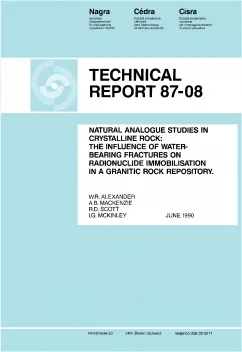
Technical Report NTB 87-08
Natural analogue studies in crystalline rock: The influence of water-bearing fractures on radionuclide in a granitic rock repository
Current Swiss concepts for the disposal of radioactive waste involve disposal in deep mined repositories to ensure that only insignificant quantities of radionuclides will ever reach the surface and so enter the biosphere. The rock formations presently considered as potential candidates for hosting radwaste repositories have thus been selected on the basis of their capacity to isolate radionuclides from the biosphere. An important factor in ensuring such containment is a very low solute transport rate through the host formation. However, it is considered likely that, in the formations of interest in the Swiss programme (e.g. granites, argillaceous sediments, anhydrite) the rocks will be fractured to some extent even at repository depth. In the instance of the cumulative failure of near-field barriers in the repository, these hydraulically connected fractures in the host formation could be very important far-field routes of migration (and possible sites of retardation) of radionuclides dissolved in the groundwaters. In this context, the so-called "matrix diffusion" mechanism is potentially very important for radionuclide retardation.
This report is the culmination of a programme which has attempted to assess the potential influence of these water-bearing fractures on radionuclide transport in a crystalline rock radwaste repository. Four rock drill-cores, which intersected suspected water-conducting fractures, were examined for indications of rockwater interactions. Elemental migration (or lack of migration) in the vicinity of the fractures has been examined by means of disequilibrium in the natural decay series. The distributions of a suite of other elements were also established for each core in an attempt to define more clearly the precise nature of any observed rock-water interactions. In general, the processes involved in the transport of any of the elements studied out of the bulk rock are analogous to those which could cause retardation of dissolved radionuclides, released from the repository, by their transport into the rock – the matrix diffusion mechanism previously mentioned.
Data are presented which indicate that a significant depth of rock (up to 0.5 m) behind a water-bearing fracture may be accessible to radionuclides in the groundwaters. Detailed petrographic examination of some of the material analysed suggests that large-scale (often hydrothermally altered) damaged zones associated with the water-bearing fractures probably allow groundwater flowing in the fractures greater access to the rock matrix in the immediate vicinity. Simple calculations imply that transport in the matrix is, however, advective and not purely diffusive as envisaged in the matrix diffusion scenario. The presence of potentially large volumes of "accessible rock" is clearly very significant for radionuclide retardation in the geosphere and the implications for safety assessment are discussed briefly.
